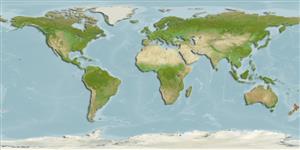Klassifizierung / Names
Namen | Synonyme | Catalog of Fishes(Gattung, Arten) | ITIS | CoL | WoRMS | Cloffa
>
Blenniiformes (Blennies) >
Tripterygiidae (Triplefin blennies) > Tripterygiinae
Eponymy: Maryann W Williams was, according to the etymology, a “…gentle lady and fine underwater photographer… …who provided photographs of this fish in the wild.” (Ref. 128868), visit book page.
Issue
This species is placed in the genus Obliquichthys in CofF ver. May 2010.
Environment: milieu / climate zone / depth range / distribution range
Ökologie
seewasser riff-verbunden; tiefenbereich 1 - 50 m (Ref. 13227). Temperate
Southwest Pacific: around mainland New Zealand.
Size / Gewicht / Alter
Maturity: Lm ? range ? - ? cm
Max length : 5.9 cm SL Männchen/unbestimmt; (Ref. 13227)
Kurzbeschreibung
Bestimmungsschlüssel | Morphologie | Morphometrie
Rückenflossenstacheln (insgesamt) : 24 - 29; Rückenflossenweichstrahlen (insgesamt) : 12 - 15; Afterflossenstacheln: 0 - 1; Afterflossenweichstrahlen: 24 - 27; Wirbelzahl: 42 - 46. Body elongated, laterally compressed posteriorly; mouth strongly angled upward; notched scales absent; short, distally complex gill rakers, body yellow with a broad, black stripe extending along upper side of body. Discontinuous lateral line with 16-22 tubular scales. Anterior 2 spines of first dorsal fin shorter than remainder, which are of equal length. No sensory papillae on frontal, temporal and upper part of otic areas. Post-temporal partially serrated. Dorsal fin formula V-0N-0-1-0-1. Ten procurrent rays in both upper and lower caudal lobes; in the upper lobe, 1 procurrent ray between upper lobe and posterior epural, 3 rays opposite posterior epural, 1 ray between posterior and anterior epurals. Two opposite anterior epural, 1 opposite neural spine of second preural vertebra; in lower lobe, 3 rays opposite haemal spine of second preural vertebra, 4 rays between haemal spines of second and third preural vertebra, 2 rays opposite haemal spine of third preural vertebra and 1 anterior haemal spine of third preural vertebra.
Facultative air-breathing in the genus (Ref. 126274); Adults are found over rocky reefs at depths of 1- 50 m (Ref. 13227) and usually seen schooling up to 5 m above substratum, although often seen resting in crevices (Ref. 84085).
Life cycle and mating behavior
Geschlechtsreife | Fortpflanzung | Ablaichen | Eier | Fecundity | Larven
Fricke, R., 1994. Tripterygiid fishes of Australia, New Zealand and the southwest Pacific Ocean (Teleostei). Theses Zool. 24:1-585. (Ref. 13227)
IUCN Rote Liste Status (Ref. 130435: Version 2024-2)
Bedrohung für Menschen
Harmless
Nutzung durch Menschen
Fischereien: nicht kommerziell
Tools
Zusatzinformationen
Download XML
Internet Quellen
Estimates based on models
Preferred temperature (Ref.
123201): 14.4 - 16.6, mean 16 °C (based on 26 cells).
Phylogenetic diversity index (Ref.
82804): PD
50 = 0.5039 [Uniqueness, from 0.5 = low to 2.0 = high].
Bayesian length-weight: a=0.00631 (0.00354 - 0.01124), b=3.08 (2.92 - 3.24), in cm total length, based on LWR estimates for this species & (Sub)family-body (Ref.
93245).
Trophic level (Ref.
69278): 3.3 ±0.4 se; based on size and trophs of closest relatives
Widerstandsfähigkeit (Ref.
120179): hoch, Verdopplung der Population dauert weniger als 15 Monate. (Preliminary K or Fecundity.).
Fishing Vulnerability (Ref.
59153): Low vulnerability (10 of 100).
Nutrients (Ref.
124155): Calcium = 88.7 [34.8, 227.5] mg/100g; Iron = 0.501 [0.205, 1.064] mg/100g; Protein = 18.6 [17.1, 20.0] %; Omega3 = 0.297 [0.108, 0.818] g/100g; Selenium = 10.1 [3.1, 31.5] μg/100g; VitaminA = 46.1 [7.6, 252.7] μg/100g; Zinc = 1.49 [0.80, 2.70] mg/100g (wet weight);
